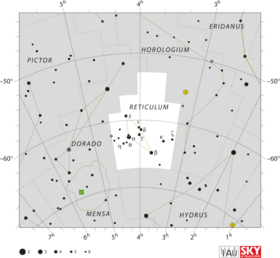Astronomy:YZ Reticuli
| Observation data Equinox J2000.0]] (ICRS) | |
|---|---|
| Constellation | Reticulum |
| Right ascension | 03h 58m 29.55s[1] |
| Declination | −54° 46′ 41.2″[1] |
| Apparent magnitude (V) | 3.7 - 18.0[2] |
| Characteristics | |
| Variable type | Nova[3] (sdB?/DA?)[4] |
| Astrometry | |
| Proper motion (μ) | RA: 7.244[1] mas/yr Dec.: 2.984[1] mas/yr |
| Parallax (π) | 0.3161 ± 0.0464[1] mas |
| Distance | 2703+365 −293[5] pc |
| Other designations | |
| Database references | |
| SIMBAD | data |
YZ Reticuli, also known as Nova Reticuli 2020 was a naked eye nova in the constellation Reticulum discovered on July 15, 2020. Previously it was known as a VY Sculptoris type object with the designation MGAB-V207.
VY Sculptoris type
The variability of the object was first discovered by an amateur astronomer, Gabriel Murawski, and reported on August 6, 2019 with the name MGAB-V207.[6] Archive photometry data from the Catalina Real-time Transient Survey and ASAS-SN showed nova-like (NL) brightness variations between magnitudes 15.8 and 17.0, exhibiting a deep dimming event in late 2006.[7] The spectrum shows a hot subdwarf (sdB) or a white dwarf origin,[4] which is consistent with VY Scl type objects.
Nova eruption
On July 15, 2020 Robert H. McNaught discovered a bright transient (magnitude 5.3)[8] coincident with the position of MGAB-V207 and it was spectroscopically confirmed by the Southern African Large Telescope (SALT) as a classical nova on July 16. The spectrum includes Balmer, OI and FeII emission lines with P Cygni profiles.[3] Spectrum analysis from observations by the Advanced Technology Telescope revealed a similarity to Nova Sagittarii 1991, three days after maximum brightness.[9] Pre-discovery images showed that the brightness peak happened on July 9, 2020 at magnitude 3.7.[10] In the days after the discovery, the nova faded by 0.2-0.3 magnitudes per day.[11] This is the third case when an already known cataclysmic variable has undergone a classical nova eruption, following V407 Cygni and V392 Persei.[12]
The orbital period of YZ Reticuli is 0.1324539 days (3 hours, 10 minutes, and 44 seconds), but in the months following the eruption, the lightcurve also oscillated with periods of 0.1384 and 0.1339 days. These are likely related to the accretion disk and represent a similar phenomenon to superhumps.[13]
See also
- List of novae in the Milky Way galaxy
References
- ↑ 1.0 1.1 1.2 1.3 1.4 Brown, A. G. A. (August 2018). "Gaia Data Release 2: Summary of the contents and survey properties". Astronomy & Astrophysics 616: A1. doi:10.1051/0004-6361/201833051. Bibcode: 2018A&A...616A...1G. Gaia DR2 record for this source at VizieR.
- ↑ Watson, C. L. (2006). "The International Variable Star Index (VSX)". The Society for Astronomical Sciences 25th Annual Symposium on Telescope Science. Held May 23–25 25: 47. Bibcode: 2006SASS...25...47W.
- ↑ 3.0 3.1 Aydi, E. et al. (2020-07-16). "SALT spectroscopic classification of MGAB-V207 as a classical nova". The Astronomer's Telegram 13867: 1. Bibcode: 2020ATel13867....1A. http://www.astronomerstelegram.org/?read=13867.
- ↑ 4.0 4.1 Kilkenny, D. (2015). "The Edinburgh-Cape Blue Object Survey - IV. Zone 3: Galactic latitudes -40° > b > -50°". Monthly Notices of the Royal Astronomical Society 1 (2): 1879. doi:10.1093/mnras/stv1771. Bibcode: 2015MNRAS.453.1879K.
- ↑ Bailer-Jones, C. A. L. (2018). "Estimating Distance from Parallaxes. IV. Distances to 1.33 Billion Stars in Gaia Data Release 2". The Astronomical Journal 156 (2): 58. doi:10.3847/1538-3881/aacb21. Bibcode: 2018AJ....156...58B.
- ↑ "VSX : Detail for N Ret 2020". https://aavso.org/vsx/index.php?view=detail.top&oid=844392.
- ↑ Murawski, G. (2019). "The discovery of eleven nova-like VY Scl type stars". http://ptma.pl/tar/TAR_2019_MGAB_VY_Scl.pdf.
- ↑ "CBET 4811: 20200715 : APPARENT NOVA IN RETICULUM (LIMITED ACCESS)". IAU. http://www.cbat.eps.harvard.edu/iau/cbet/004800/CBET004811.txt.
- ↑ Carr, A. et al. (2020-07-18). "WiFeS follow-up observations of the naked-eye nova associated to MGAB-V207". The Astronomer's Telegram 13874: 1. Bibcode: 2020ATel13874....1C. http://www.astronomerstelegram.org/?read=13874.
- ↑ "CBET 4812: 20200716 : NOVA RETICULI 2020 (LIMITED ACCESS)". IAU. http://www.cbat.eps.harvard.edu/iau/cbet/004800/CBET004812.txt.
- ↑ "Recent Nova Reticuli 2020 observations in AAVSO". https://www.aavso.org/apps/webobs/results/?star=NOVA%20RETICULI%202020&num_results=200.
- ↑ Li, K. et al. (2020-07-16). "Fermi-LAT detection of the naked-eye classical nova MGAB-V207". The Astronomer's Telegram 13868: 1. Bibcode: 2020ATel13868....1L. http://www.astronomerstelegram.org/?read=13868.
- ↑ Schaefer, Bradley E. (2021). "Discovery of 13 New Orbital Periods for Classical Novae". Research Notes of the AAS 5 (6): 150. doi:10.3847/2515-5172/ac0d5b. Bibcode: 2021RNAAS...5..150S.
External links
- VY Sculptoris type discovery details, July 15, 2020
- Nova Reticuli 2020 bursts into the southern skies - Astronomy.com, July 17, 2020
- Bright Nova Reticuli 2020 - blog by Ernesto Guido, July 17, 2020
 |



